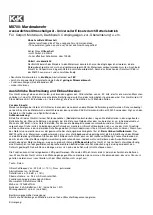
WavePro 700Zi
513
WP700Zi-OM-E-RevA
The Advanced Menu
The Advanced Menu contains information and functionality useful to the advanced user of the TF-DSQ fixture.
These include:
x
Risetime Skew Correction
x
Deskew All
(or common deskew capability)
x
Common mode voltage settings for DC calibration
Rise Time Skew Correction
This field shows the signal risetime and the corresponding skew correction based on the signal risetime.
When probes are deskewed, the risetime measurement of the edge used for deskewing is displayed in the
Rise
Time
field corresponding to the probe and probe channel, and an additional skew correction of zero is applied.
The measured risetime of the signals encountered can be entered into the
Rise Time
field, and the scope will
automatically calculate and apply a new skew correction value to be utilized in addition to the deskew amount
calculated during the deskew calibration procedure. With this use, a finer deskew calibration is performed
because the risetimes of the signals measured are accounted for. See details of
risetime correction
.
Deskew All (or Common Skew)
This is the deskew amount applied to all channels. The time entered in this field is the absolute time by which all
waveforms displayed by the scope are delayed in time. This value effectively adjusts the zero time reference of
the system. See
Probe Deskew Calibration
for details.
Common Mode Voltage Selection
The TF-DSQ fixture will calibrate probes differentially or in single-ended mode depending on the type of probe.
Differential probes allow the common mode voltage component to be applied during the DC calibration for
improved calibration accuracy in situations where probe gain or offset correction depends on common mode
components. See
Probe DC Calibration
or
Differential and Single-ended Probe Basics
for details.
Advanced Probe Calibration
When the
Advanced Mode
checkbox is checked, you can perform the DC calibration and the deskew calibration
separately by pressing
Gain/Offset Only
or
Deskew Only
.
When performing DC calibration, you have the option to apply a
common mode component
to the differential DC
levels applied to the probe during calibration. See
Probe DC Calibration
or
Differential and Single-ended Probe
Basics
for details..
After performing the deskew calibration, you have the option to apply a
common skew
value to all channels to
adjust the zero time reference of the system.
If you know the risetime of the signals being measured, you can enter the measured risetime of the signals in the
Rise Time
field to obtain a further skew correction that accounts for the risetime. If the risetime entered is less
than the risetime measured during the calibration, no correction is applied; otherwise, the system will calculate a
correction to account for the signal risetime. It is important to enter the measured risetime. That is the risetime of
the signal that the scope measures (or will measure). See details of
risetime correction
.
Содержание DDA 7 Zi series
Страница 1: ...Operator s Manual WavePro SDA and DDA 7 Zi Series Oscilloscopes ...
Страница 2: ... L R R H HUD RU D D ...
Страница 41: ...Operator s Manual WP700Zi OM E RevA 40 The detachable WavePro Zi front panel ...
Страница 376: ...WavePro 7Zi 375 WP700Zi OM E RevA Absolute Offset Relative ...
Страница 439: ...Operator s Manual WP700Zi OM E RevA 438 ...
Страница 440: ...WavePro 7Zi 439 WP700Zi OM E RevA ...
Страница 544: ...Thank you for purchasing a WavePro SDA or DDA 7 Zi Oscilloscope ...
















































